"Nature" and "Science" Week (6.11-6.17) Frontiers of Materials Science
1. Ferromagnetic domain printing for unbound fast transition soft materials
(Printing ferromagneticdomains for untethered fast-transforming soft materials)
Material Name: Magnetically Responsive Soft Material
Research team: MIT Shawn A. Chester and Xuanhe Zhao Research Group
Soft materials capable of responding to stimuli such as light, heat, solvents, electric fields, and magnetic fields and transforming between three-dimensional (3D) shapes have been applied in many fields, such as flexible electronics, software robotics, and Biomedical Science. In particular, magnetic fields provide a safe and efficient method of operation for biomedical applications, enabling remote driving in closed and limited spaces. As magnetic field control advances, flexible magnetically responsive materials have also evolved and evolved from the incorporation of discrete magnets or the incorporation of magnetic particles into soft compounds to create a non-uniform magnetization distribution in the polymer sheet. Zhao et al. reported 3D printing of programmed ferromagnetic domains in soft materials, which led to a rapid transition between complex 3D shapes by magnetic drive. This method is based on direct printing of elastomeric composites containing ferromagnetic particles. The printed filaments are imparted with a patterned magnetic polarity by applying a magnetic field to the dispensing nozzle during printing and reorienting the particles along the applied field. This approach enables the ferromagnetic domain to be programmed in complex 3D printed soft materials to achieve a range of previously unattainable transition modes, such as remote controlled swell of mechanical metamaterials with negative Poisson's ratio. Printed soft materials with programmed ferromagnetic domains have drive orders and power densities that are orders of magnitude larger than existing 3D printed active materials. Zhao et al. further demonstrated the many functions derived from complex shape changes, including reconfigurable soft electronic devices, mechanical metamaterials that can jump, and soft robots that crawl, roll, capture fast moving objects, and deliver drug doses. )
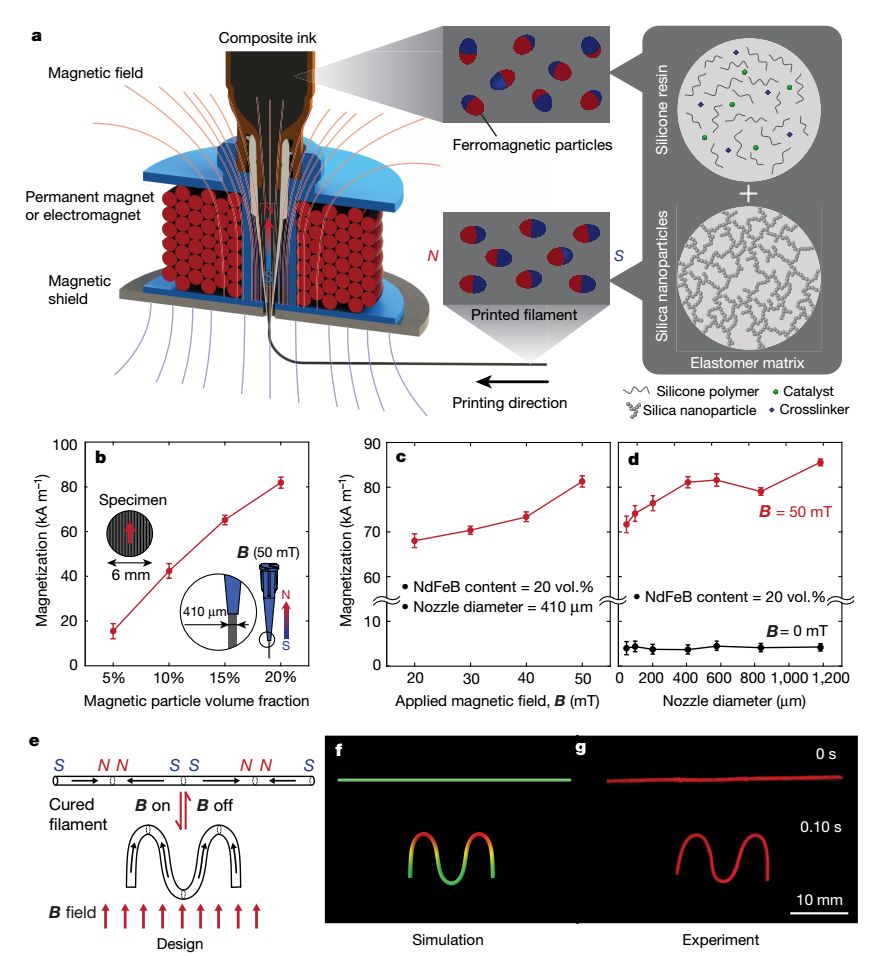
2. Giant tunneling magnetoresistance in spin-filtered van der Waals heterostructure
(Gianttunneling magnetoresistance in spin-filter van der Waals heterostructures)
Material Name: Chromium Triiodide (CrI3)
Research Team: Xu Xiaodong Research Group, University of Washington, USA
Magnetic multilayer devices using magnetoresistance are a major part of magnetic induction and data storage technologies. Xu et al. reported multi-spin filter magnetic tunnel junctions (sf-MTJs) based on van der Waals (vdW) heterostructures in which atomic-thickness chromium triiodide (CrI3) acts as a spin between graphene Filter the tunneling barrier. It is also shown that the tunneling magnetoresistance increases sharply with the increase of the CrI3 layer thickness, and the magnetic multilayer structure using four layers of sf-MTJs reaches a record of 19,000% at low temperatures. Xu et al. used magnetic circular dichroism measurements to attribute these effects to the intrinsic layer-by-layer antiferromagnetic ordering of atomic CrI3. This work reveals the possibility of driving magnetic information storage to the atomic thickness limit and highlights the high magnetic tunneling barrier of CrI3 as a vdW heterojunction spintronic device.
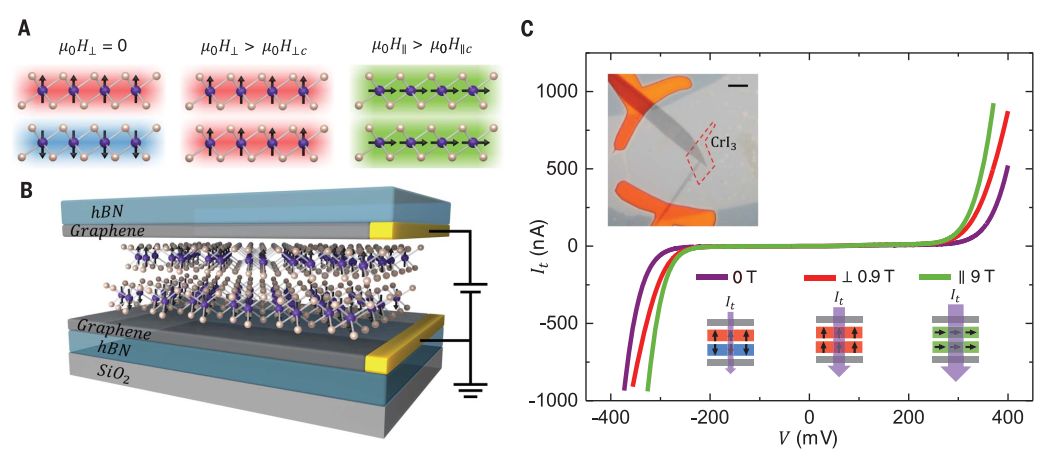
3. Fully textured monolithic perovskite/silicon tandem solar cell with 25.2% power conversion efficiency
(Fully textured monolithic perovskite/silicon tandemsolar cells with 25.2% power conversion efficiency)
Material Name: Perovskite / Silicon Tandem Solar Cell
Research team: Quentin Jeangros Research Group, Federal Institute of Technology, Lausanne
Combining tandem devices of perovskites and silicon solar cells, it is expected to achieve more than 30% power conversion efficiency at a reasonable cost. The most advanced single-piece, double-ended perovskite/silicon tandem device to date is based on silicon and polished to the front to be compatible with the perovskite manufacturing process. This concession leads to higher potential production costs, higher reflection losses and makes the light capture situation less than ideal. To solve this problem, Jeangros et al. developed a top cell deposition process that enables conformal growth of a variety of compounds with controlled optoelectronic properties directly on monocrystalline silicon micron-sized pyramid textures. A series device with a silicon heterojunction cell and a nanocrystalline silicon recombination junction exhibits a certified steady state efficiency of 25.2%. This optical design by Jeangros et al. produced a current density of 19.5 mA·cm-2 (thanks to the pyramidal structure of silicon) and provided a way to achieve a 30% monolithic perovskite/silicon tandem device.
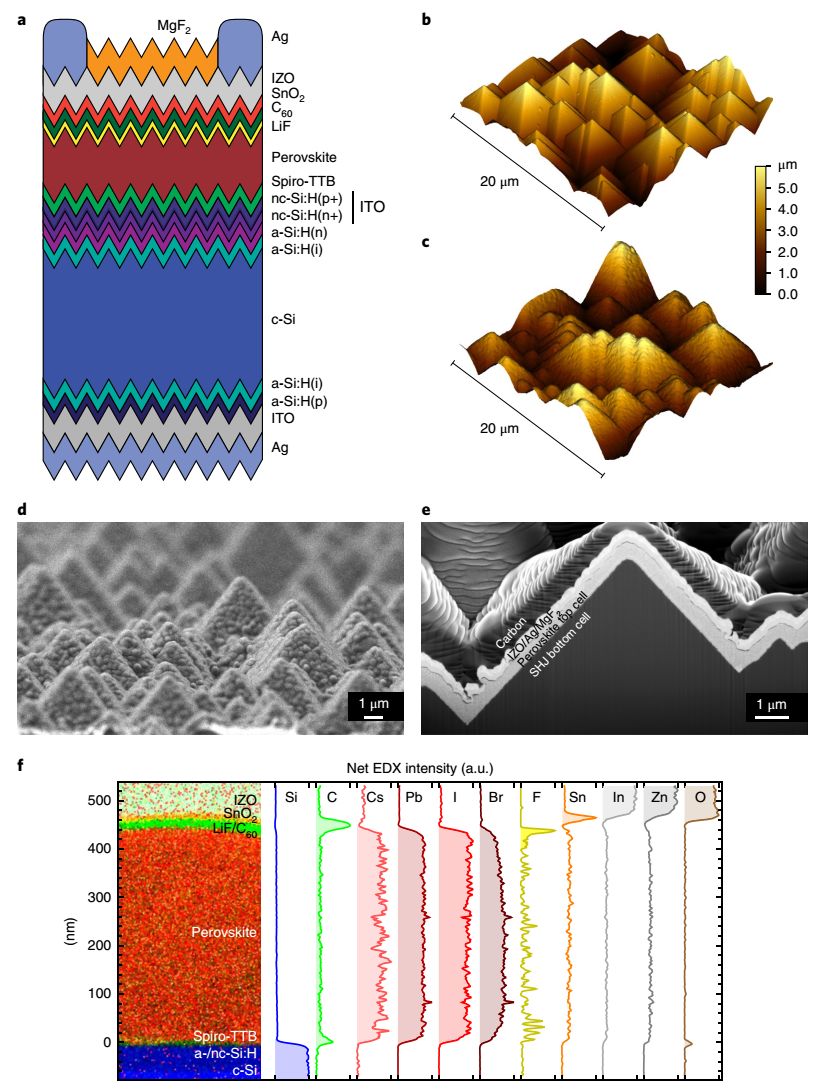
4. Tantalum and aluminum doping to achieve the capacity limit of LiCoO2 electrode in lithium ion battery
(Approachingthe capacity limit of lithium cobalt oxide in lithium ion batteries vialanthanum and aluminium doping)
Material Name: Tantalum and Aluminum Doped LiCoO2 Electrode
Research team: Argonne National Laboratory and China Huawei Research Team
LiCoO2 has a high theoretical specific capacity (274 mAh/g). However, the electrode voltage based on LiCoO2 tends to cause structural instability and severe capacity decay with respect to Li/Li+ exceeding 4.35V. Therefore, the commercialized amount of liCoO2 shows a maximum capacity of only about 165 mAh/g. Liu et al. developed a doping technique that could solve this long-term cyclic instability and increase the capacity of LiCoO2. La and Al are co-doped in the lattice of LiCoO2, in which La acts as a pillar to increase the spacing of the c-axis, while Al acts as a positive charge center to promote the migration of Li+, and can stabilize the structure and suppress the cycle even at a cut-off voltage of 4.5V. Phase change. This doped LiCoO2 electrode exhibits a very high capacity (190 mAh/g), maintains a 96% capacity for a stable cycle of 50 cycles, and improves the material's rate performance.
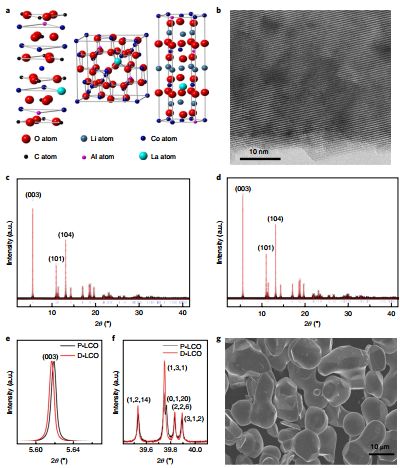
5. Single metal site catalysts for homogeneous catalysis and heterogeneous catalysis
(Bridginghomogeneous and heterogeneous catalysis by heterogeneous single-metal-site catalysts)
Material Name: Heterogeneous Single Metal Catalytic Site Catalyst
Research team: Matthias Beller Research Group, University of Rostock, Germany
In heterogeneous single metal catalytic site catalysts (HSMSCs), the active metal centers are individually located on the support and are stabilized by adjacent surface atoms such as N, O or S. Modern characterization techniques are capable of determining these single metal atoms on a given support, and these materials are often referred to as monoatomic catalysts. Their electronic and catalytic activities can be regulated by the interaction of central atoms and adjacent surface atoms. Their atomic dispersion properties allow metal utilization to reach 100%. In this way, HSMSCs can provide new opportunities for catalysis and structurally bridge the gap between homogeneous and heterogeneous catalysis. Cui et al. summarized the articles published in this field since 2010 and put forward their views on future development. Where appropriate, HSMSCs were also compared to homogeneous/heterogeneous catalysts.
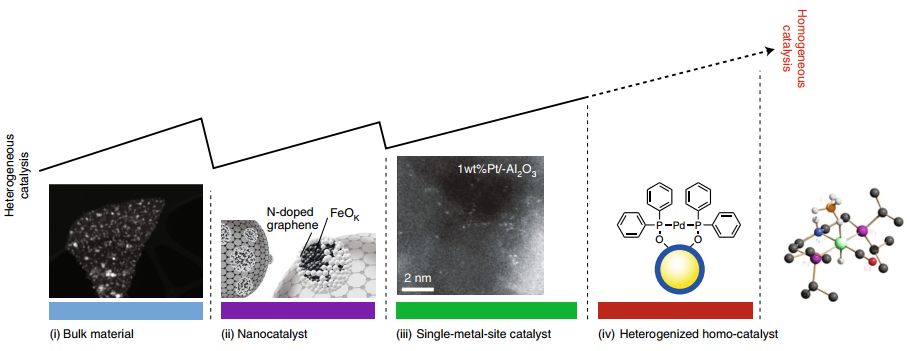
6. Detection of magnetic properties in two-dimensional van der Waals crystalline insulators by electron tunneling
(Probingmagnetism in 2D van der Waals crystalline insulators via electron tunneling)
Material Name: Two-dimensional van der Waals crystalline insulator
Research team: Jarillo-Herrero Research Group, Massachusetts Institute of Technology
Magnetic insulators are key in next-generation spin and topology devices. The family of layered metal halides has a variety of magnetic states, including ultra-thin insulating multiferroic materials, spin liquids, and ferromagnets, but device-directed characterization techniques used to unlock these potentials are still lacking. Klein et al. reported the tunneling effect in the layered magnetic insulator CrI3 as a function of temperature and applied magnetic field. They detected several magnetic and inter-layer couplings and observed a field-induced magnetic transition. This transition results in a two-layer CrI3 barrier of 95%, three layers of 300%, and four layers of 550% of magnetoresistance, respectively. They further measured the inelastic tunneling spectrum and revealed the spectral uniformity of the collective magnetic excitation (magnetons) in CrI3.
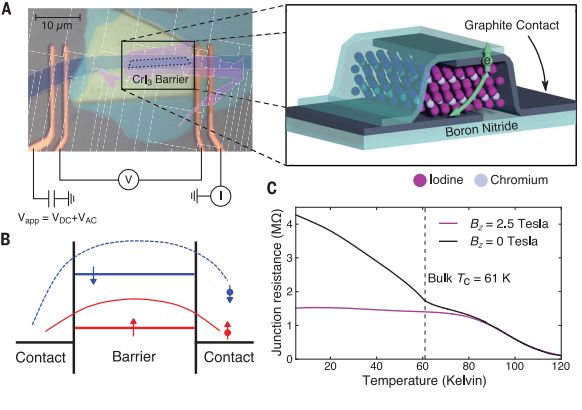
7. Reversible NO2 adsorption in porous metal organic framework compounds
(Reversible adsorption of nitrogen dioxide within a robust porousmetal–organic framework)
Material Name: MFM-300 (Al)
Research team: Yang and Schröder Research Group, University of Manchester, UK
NO2 is a major pollutant in the air that can cause important environmental and health problems. Han et al. reported a metal organic framework compound capable of reversibly adsorbing NO2. At room temperature, MFM-300 (Al) exhibits a reversible NO2 isothermal adsorption (14.1 mmol/g) and, more importantly, it selectively adsorbs low concentrations of NO2 (5000 to < 1 ppm) in the gas mixture. . Comprehensive experiments revealed five supramolecular interactions in MFM-300 that bind to both NO2 and N2O4 molecules. They found that the in-situ equilibrium of 2NO2N2O4 in the pores is non-pressure dependent, whereas the ex situ balance is a typical pressure dependent first ordered process. This helical NO2 monomer-double chain in MFM-300 (Al) provides the basis for understanding the chemical nature of the guest molecules in the porous body. This work may provide ideas for the development of future capture and transformation technologies.
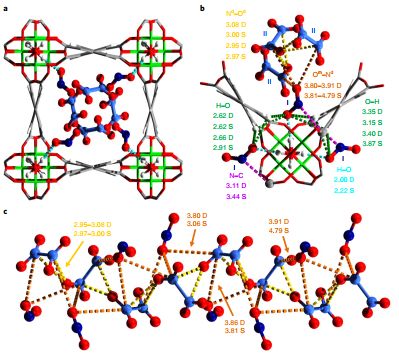
8. Interaction of water and active elements in the formation of alumina in alloys
(Interplay of water and reactive elements in oxidation of alumina-forming alloys)
Material Name: Alumina
Research team: I. Panas and LG Johansson Research Group, Chalmers University of Technology, Sweden
High temperature resistant alloys are vital to many important technologies that support our civilization. All of these materials rely on an external oxide layer for corrosion protection. Despite decades of research into the growth of oxide layers, there are still many unresolved problems, including the so-called active elements and water that play a key role. Johansson et al. disclose the hitherto unknown interaction between active elements and water during alumina growth, thereby promoting the formation of metastable "cluttered" nanostructured alumina layers. It is also proposed that the hydroxylation interface of the active element modification between the alumina nanoparticles promotes the entry of water into the internal cathode at the bottom of the layer, which is inconsistent with the growth of the layer. Co-variation of hydrogenated nanodomains and active elements/hydrogen (æ°˜) was observed in the alumina layer as evidence. The defect-rich alumina is then recrystallized to form a protective layer. And Johansson et al. verified the RE effect by first-principles modeling. This research opens up a very promising approach to oxidation research and proposes ways to improve alloy properties.
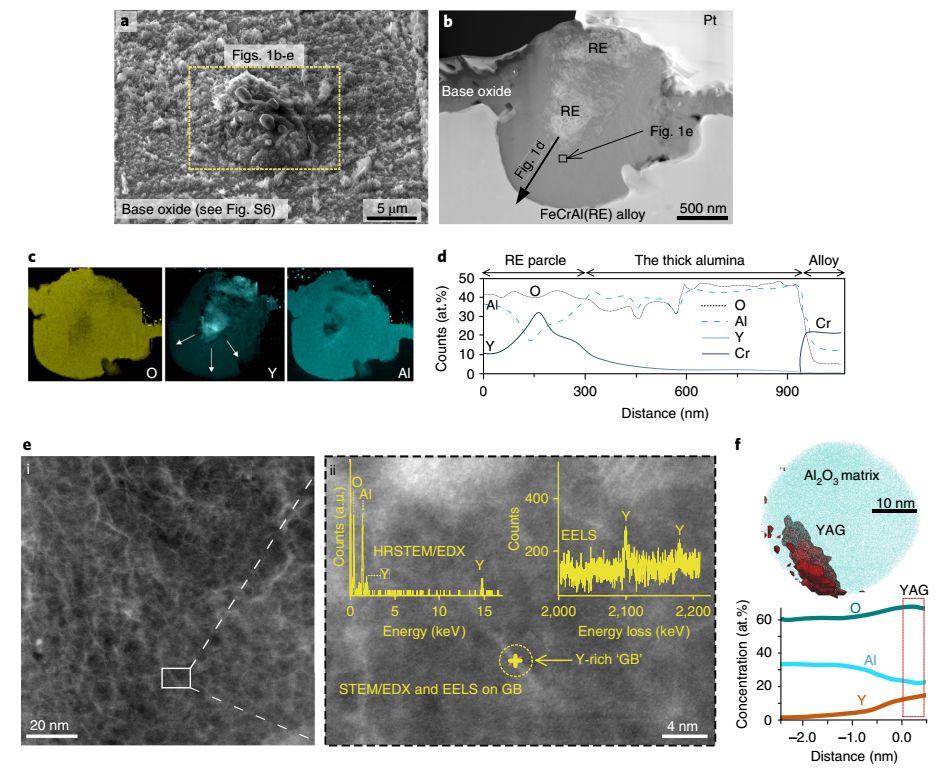
9. Single-layer graphene regulates neuronal communication and amplifies membrane ion current
(Single-layer graphene modulates neuronal communication and augmentsmembrane ion currents)
Material Name: Single layer graphene
Research team: Scaini Research Group, Italian Institute of Advanced Studies
The use of graphene-based materials to regulate complex biosensing interfaces that adapt to the central nervous system requires a detailed understanding of the behavior of these materials in the biological environment. The special properties of graphene can cause a variety of cellular changes, but the underlying mechanisms remain unclear. Pampaloni et al. found that monolayer graphene can increase neuronal firing in cultured cells by altering membrane-related functions. Graphene is capable of regulating the distribution of external cellular ions at the interface with neurons. Theoretical and experimental studies have shown that graphene-ion interactions are maximized when single-layer graphene is deposited on an electrically insulating substrate and are critical.
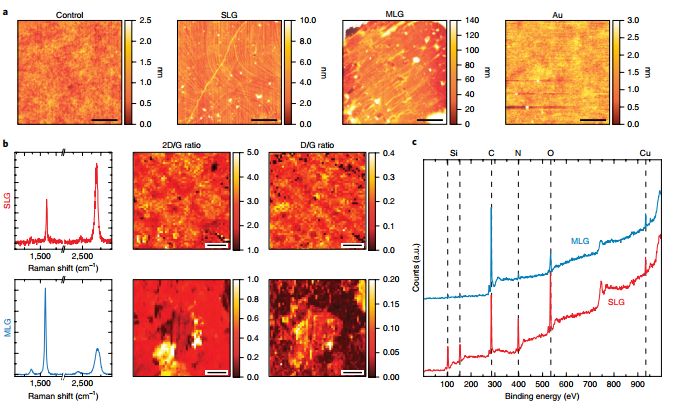
Great Wall Texture PU Sandwich Panel
Metal surface insulation pu foam wall decorative panel great wall type
Rich selection of textures and colors meet different decoration requirements, giving the city and the buildings a new look.
The PU foam is the most advanced and eco-friendly insulation material in the world. With the help of the back aluminum foil, the thermal preservation effect achieves the best.
The unique structure prevents the heat loss in winter. Meanwhile it reduces the heat of the summer sunshine.
Aceta paintcoat and flurocarbon paint of weather resistance performance are applied on surface of wall panel. It is reserved with superior self-cleaning, weather resistance, corrosion resistance and acid& alkali resistance performance.
Light weight with 3.7Kgs/m2 makes the installation easy.
The installation process is clean and tidy without any noise and dust, construction waste.
Different selections of accessories meet different effects.
High quality and stable performance: Manufactured in CNC automation production line, the product pass rate can reach 99.9% with stable chemical structure and physical structure.
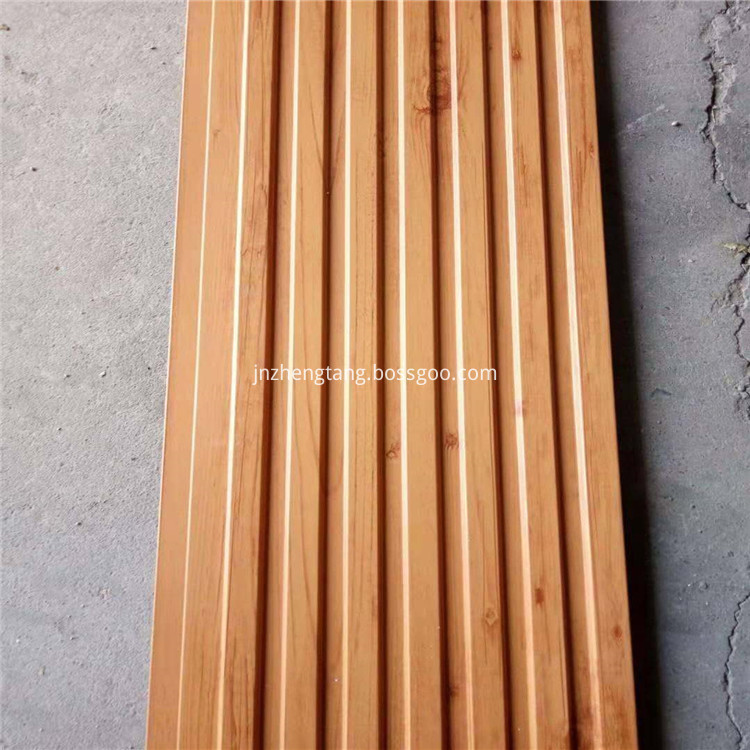
Sandwich Panel,Composite Insulated Panels,Composite Siding Panels,Great Wall Texture Pu Sandwich Panel
Jinan Zhengtang Insulation Decoration Material Co.Ltd , https://www.ztwallsiding.com